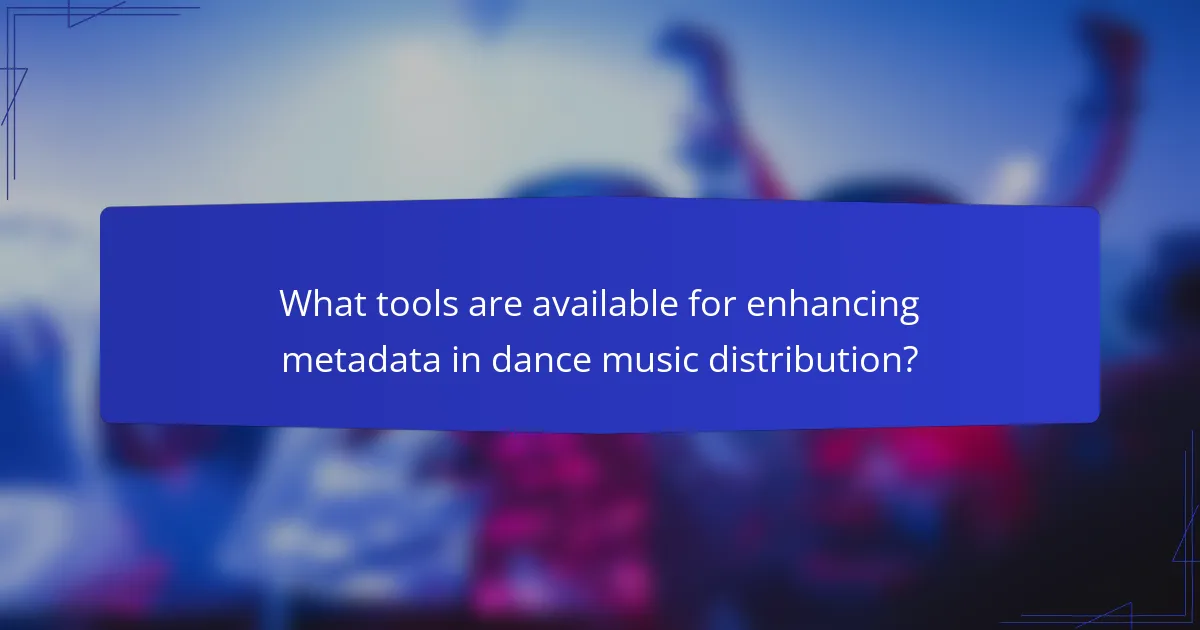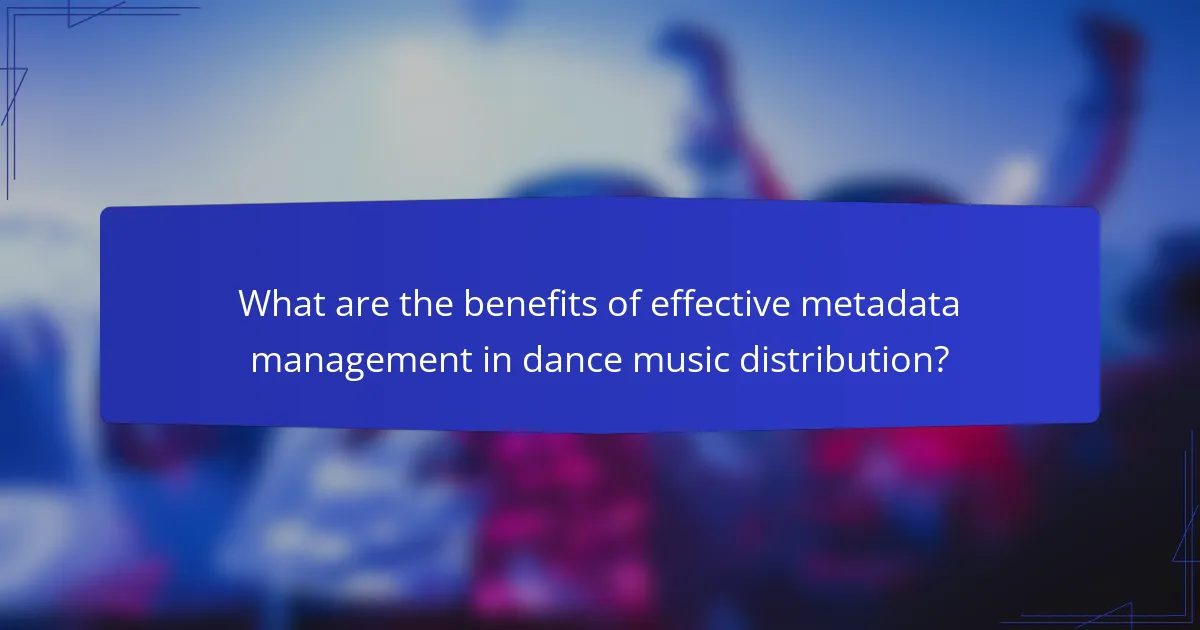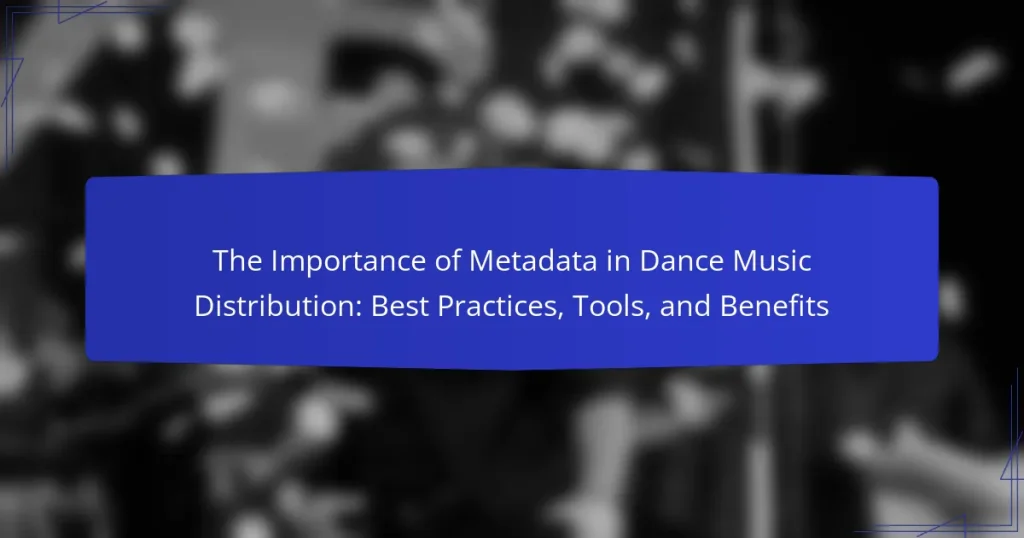Metadata is a critical component in dance music distribution, serving to accurately identify and categorize tracks through essential information such as artist name, track title, genre, and release date. This structured data enhances discoverability on streaming platforms, aids in royalty collection, and improves user experience by simplifying music searches. Best practices for managing metadata include ensuring accuracy, consistency, and completeness, as well as utilizing standardized codes and management tools. Various tools, including digital audio workstations (DAWs) and metadata management software, facilitate the embedding and optimization of metadata, ultimately streamlining the distribution process and maximizing revenue opportunities for artists and labels.

What is the importance of metadata in dance music distribution?
Metadata is crucial in dance music distribution as it ensures accurate identification and categorization of tracks. It includes essential information such as artist name, track title, genre, and release date. This information helps digital platforms organize music effectively. Accurate metadata improves discoverability on streaming services. It aids in royalty collection by providing necessary details for licensing and distribution. Furthermore, well-structured metadata enhances user experience by allowing listeners to find music easily. According to a report by the International Federation of the Phonographic Industry (IFPI), proper metadata can significantly increase streaming revenue. Thus, metadata plays a vital role in the success of dance music distribution.
How does metadata influence the distribution of dance music?
Metadata significantly influences the distribution of dance music by providing essential information for categorization and discovery. It includes details such as genre, artist name, track length, and release date. This information helps streaming platforms and digital stores accurately classify and recommend music to listeners. Accurate metadata improves searchability, making it easier for fans to find specific tracks. Additionally, metadata facilitates licensing and copyright management, ensuring that artists receive proper credit and royalties. Research shows that tracks with complete and accurate metadata are more likely to be streamed and purchased. Thus, effective metadata management directly impacts the visibility and success of dance music in digital marketplaces.
What are the key elements of metadata in dance music?
The key elements of metadata in dance music include track title, artist name, album name, genre, and release date. Track title identifies the specific song. Artist name denotes the creator of the music. Album name provides context for the collection of tracks. Genre categorizes the style of music, aiding in audience targeting. Release date indicates when the music was made available. Additional elements may include ISRC codes, BPM (beats per minute), and copyright information. These elements enhance discoverability and organization in digital music platforms. Accurate metadata ensures proper licensing and royalty distribution.
How does metadata impact the visibility of dance music tracks?
Metadata significantly impacts the visibility of dance music tracks by providing essential information for search algorithms. Accurate metadata includes details like title, artist, genre, and release date. This information helps streaming platforms categorize and recommend tracks effectively. When metadata is optimized, it increases the likelihood of appearing in search results. For instance, tracks with complete and precise metadata are more likely to be featured in curated playlists. Research shows that 70% of listeners discover new music through playlists, highlighting the importance of metadata in visibility. Furthermore, metadata aids in tracking performance metrics, allowing artists to adjust marketing strategies. Thus, well-structured metadata is crucial for maximizing the reach and impact of dance music tracks.
Why is accurate metadata crucial for artists and labels?
Accurate metadata is crucial for artists and labels because it ensures proper identification and crediting of their work. It helps in organizing music for distribution across platforms. Accurate metadata includes essential details like artist name, track title, and genre. This information is vital for digital streaming services and music libraries. Correct metadata increases discoverability, allowing listeners to find music easily. It also influences royalty payments, ensuring artists receive fair compensation. According to a study by the Music Industry Research Association, accurate metadata can boost streaming revenue by up to 30%. Thus, precise metadata is essential for maximizing visibility and revenue in the music industry.
How does metadata affect royalties and revenue for artists?
Metadata directly affects royalties and revenue for artists by ensuring accurate tracking and reporting of music usage. Proper metadata includes details like song title, artist name, and genre. This information helps streaming services and performance rights organizations identify and compensate artists correctly. For instance, accurate metadata can lead to higher royalty payments, as it facilitates proper allocation of funds. According to the Music Industry Revenue Report, accurate metadata can increase an artist’s revenue by up to 30%. Additionally, metadata plays a crucial role in digital distribution, impacting how music is categorized and discovered by listeners. Inaccurate or missing metadata can result in lost revenue opportunities and unrecognized performances. Thus, comprehensive metadata management is essential for maximizing earnings in the music industry.
What role does metadata play in audience engagement and discovery?
Metadata enhances audience engagement and discovery by providing essential information about content. It includes details like title, artist, genre, and release date. This information helps users find relevant music through search engines and platforms. Accurate metadata improves searchability, making it easier for fans to discover new artists. According to a study by the International Federation of the Phonographic Industry, 70% of consumers use search functions to find music. Well-structured metadata increases the chances of appearing in search results. This ultimately leads to higher engagement rates and more streams.

What are the best practices for managing metadata in dance music?
The best practices for managing metadata in dance music include ensuring accuracy, consistency, and completeness. Accurate metadata helps in identifying tracks correctly. Consistent formatting across all platforms is crucial for seamless distribution. Complete metadata includes information like artist name, track title, genre, and release date. Using standardized codes like ISRC for tracks aids in tracking sales and streams. Regularly updating metadata is essential to reflect any changes, such as remixes or collaborations. Utilizing metadata management tools can streamline the process and reduce errors. Engaging with distributors who prioritize metadata accuracy can enhance visibility on streaming platforms.
How can artists ensure their metadata is accurate and complete?
Artists can ensure their metadata is accurate and complete by following specific guidelines. First, they should use reliable metadata management tools. These tools help standardize information such as track titles, artist names, and genres. Second, artists must verify their information against official sources. This reduces errors caused by typos or incorrect data. Third, regular updates are essential. As details change, such as collaborations or remixes, artists should promptly revise their metadata. Fourth, artists should review metadata before distribution. This final check helps catch any inaccuracies. Lastly, seeking feedback from peers can provide additional insights into potential errors. By adhering to these practices, artists can maintain high-quality metadata in their music distribution.
What tools can be used for metadata management in dance music?
Tools for metadata management in dance music include platforms like TuneCore, DistroKid, and CD Baby. These services help artists manage their track information, including titles, artist names, and genre classifications. Additionally, software like MusicBrainz and Discogs provides comprehensive databases for cataloging music metadata. These tools ensure accurate distribution and proper crediting of artists. They also facilitate compliance with digital distribution standards. Using these tools helps enhance visibility and reach in the competitive dance music market.
How frequently should metadata be updated and reviewed?
Metadata should be updated and reviewed regularly, ideally every six months. This ensures accuracy and relevance in the rapidly evolving music industry. Regular updates help maintain compliance with distribution platforms’ requirements. Additionally, reviewing metadata can enhance discoverability and improve user engagement. Consistent checks can identify outdated information or errors. Monitoring changes in industry standards is also crucial. Adopting a proactive approach to metadata management supports better visibility for dance music releases.
What common mistakes should be avoided in metadata management?
Common mistakes in metadata management include inconsistent naming conventions. This inconsistency can lead to confusion and misidentification of tracks. Another mistake is neglecting to update metadata regularly. Outdated information can result in incorrect data being shared across platforms. Failing to include essential attributes, such as artist names or track lengths, can hinder discoverability. Additionally, overlooking the importance of accurate genre classification can affect audience targeting. Not validating metadata before distribution can lead to errors that impact sales and streaming. Lastly, ignoring the need for comprehensive documentation can create challenges in maintaining metadata over time.
How can incorrect metadata affect a dance track’s performance?
Incorrect metadata can significantly hinder a dance track’s performance. Metadata includes vital information like the track title, artist name, and genre. If this information is incorrect, listeners may struggle to find the track. Search engines and streaming platforms rely on accurate metadata for categorization. Mislabeling can lead to lower visibility in search results. Additionally, incorrect genre classification can mislead potential listeners. This may result in fewer plays and engagement. Studies show that tracks with accurate metadata perform better in playlists and charts. Thus, proper metadata is essential for maximizing a dance track’s reach and success.
What are the consequences of neglecting metadata in distribution?
Neglecting metadata in distribution can lead to significant issues. Poor metadata results in reduced visibility on streaming platforms. This decreases the chances of reaching a wider audience. Inaccurate or missing data can cause misattribution of tracks. This misattribution affects royalties and revenue distribution negatively. Additionally, it can hinder promotional efforts and marketing strategies. Without proper metadata, collaborations might not be credited correctly. This can damage relationships within the music industry. Overall, neglecting metadata compromises the effectiveness of distribution channels.

What tools are available for enhancing metadata in dance music distribution?
Tools available for enhancing metadata in dance music distribution include digital audio workstations (DAWs), metadata management software, and online distribution platforms. DAWs like Ableton Live and Logic Pro allow artists to embed metadata directly into their audio files. Metadata management software such as TuneCore and DistroKid helps organize and optimize metadata for distribution. Online platforms like Spotify for Artists and Apple Music for Artists provide tools to edit and enhance metadata for better visibility. These tools ensure accurate information is associated with tracks, improving discoverability and listener engagement.
Which software solutions are popular for metadata management?
Popular software solutions for metadata management include Apache Atlas, Talend, and Informatica. Apache Atlas provides data governance and metadata management capabilities. Talend offers integration and data quality tools with metadata management features. Informatica specializes in enterprise data integration and management, including metadata solutions. These tools help organizations maintain accurate and consistent metadata across various data sources.
How do these tools integrate with music distribution platforms?
These tools integrate with music distribution platforms by automating metadata management and ensuring accuracy. They enable artists to upload tracks with essential metadata, such as title, artist name, and genre. This integration streamlines the distribution process, allowing for faster release times. Additionally, tools often provide analytics to track performance across platforms. Many distribution services utilize APIs to connect with these tools seamlessly. This connection ensures that all metadata is consistent and compliant with industry standards. Accurate metadata is crucial for proper royalties and licensing. Overall, the integration enhances the efficiency and effectiveness of music distribution.
What features should artists look for in metadata management tools?
Artists should look for user-friendly interfaces in metadata management tools. A simple interface allows for easy navigation and efficient data entry. Additionally, robust data validation features ensure accuracy in metadata. These features minimize errors that could affect distribution. Comprehensive reporting capabilities are also essential. They provide insights into how metadata is performing across platforms. Integration with various distribution services enhances workflow. Artists benefit from seamless connections to platforms like Spotify and Apple Music. Customizable fields allow artists to tailor metadata to their specific needs. This flexibility supports unique branding and marketing strategies. Finally, strong security measures protect sensitive information. Data breaches can harm an artist’s career and reputation.
What are the benefits of using specialized metadata tools?
Specialized metadata tools enhance organization and discoverability of digital content. They streamline the process of tagging and categorizing music files. This leads to improved searchability on music platforms. Accurate metadata ensures proper attribution to artists and producers. It also helps in maintaining copyright compliance. Enhanced metadata can increase a track’s visibility in playlists and recommendations. Studies show that well-tagged music can lead to higher streaming numbers. Overall, these tools optimize the distribution process in the music industry.
How can these tools streamline the distribution process?
These tools streamline the distribution process by automating metadata management. Automation reduces manual input errors and saves time. They ensure accurate and consistent metadata across platforms. This consistency improves discoverability on streaming services. Enhanced discoverability leads to increased listener engagement. Tools also facilitate faster updates to metadata as needed. Quick updates keep information relevant and accurate. Overall, these efficiencies lead to a smoother distribution workflow.
What impact do they have on the overall success of dance music releases?
Metadata significantly impacts the overall success of dance music releases. It ensures accurate categorization and discoverability of tracks. Proper metadata helps streaming platforms recommend music effectively. This can lead to increased plays and fan engagement. Accurate metadata also aids in royalty collection for artists. Studies show that well-tagged releases perform better in charts. Additionally, metadata influences how music is indexed by search engines. Overall, metadata is crucial for maximizing reach and revenue in dance music distribution.

What are the benefits of effective metadata management in dance music distribution?
Effective metadata management in dance music distribution enhances discoverability and organization. Accurate metadata allows platforms to categorize tracks properly. This categorization improves search results for users. Enhanced searchability leads to increased streaming and sales. Consistent metadata ensures that artists receive proper credit for their work. It also facilitates royalty tracking and payment distribution. Additionally, effective metadata management helps in marketing efforts by targeting specific audiences. Overall, it streamlines the distribution process and maximizes revenue opportunities for artists and labels.
How does effective metadata enhance marketing strategies for dance music?
Effective metadata enhances marketing strategies for dance music by improving discoverability and audience targeting. Accurate metadata includes genre, BPM, and mood, which helps platforms categorize tracks effectively. This categorization increases the chances of tracks appearing in relevant playlists. Enhanced visibility leads to higher streaming numbers and fan engagement. Furthermore, metadata allows for targeted advertising based on listener preferences. According to a study by Nielsen Music, songs with detailed metadata receive 30% more engagement on streaming platforms. This data indicates that effective metadata is crucial for maximizing marketing impact in the dance music industry.
What role does metadata play in playlist placements and streaming success?
Metadata is crucial for playlist placements and streaming success. It provides essential information about the music, such as title, artist, genre, and release date. Accurate metadata helps streaming platforms categorize and recommend tracks effectively. This increases the likelihood of being featured on playlists. Playlists significantly boost visibility and listener engagement. According to a study by the International Federation of the Phonographic Industry, 75% of music discovery occurs through playlists. Therefore, well-structured metadata directly influences a track’s reach and popularity. In summary, metadata enhances discoverability and plays a vital role in overall streaming performance.
How can metadata improve collaboration between artists and labels?
Metadata can improve collaboration between artists and labels by providing clear information about music tracks. This information includes details like songwriters, producers, and release dates. Accurate metadata ensures that all parties have access to the same data, reducing misunderstandings. It also helps in tracking royalties and sales, facilitating fair compensation for artists. According to the International Federation of the Phonographic Industry (IFPI), proper metadata can increase the efficiency of music distribution. Moreover, it enables better marketing strategies by allowing labels to understand audience engagement. Enhanced data sharing fosters stronger partnerships between artists and labels. Thus, effective metadata management is crucial for successful collaboration in the music industry.
What practical tips can artists follow for effective metadata management?
Artists should use consistent naming conventions for their files. This helps in easily identifying and organizing their work. They should include essential information in their metadata. Key details include title, artist name, genre, and release date. Artists must ensure that all metadata fields are filled out accurately. Missing information can lead to misidentification or loss of revenue. Regularly updating metadata is crucial for maintaining relevance. This is particularly important when releasing new versions or remixes. Utilizing software tools for metadata management can streamline the process. These tools often provide templates and automate data entry, reducing errors. Lastly, artists should back up their metadata regularly. This protects their work from data loss and ensures continuity in their distribution efforts.
How can artists develop a consistent metadata strategy?
Artists can develop a consistent metadata strategy by establishing standardized naming conventions. They should create a template for essential metadata fields such as title, artist name, and genre. This ensures uniformity across all releases. Regularly updating metadata for existing tracks is also important. Consistency in formatting, such as using the same capitalization style, enhances discoverability. Artists should utilize metadata management tools to streamline the process. These tools can help automate and enforce standards. Additionally, collaborating with distributors can provide guidance on best practices. Following industry guidelines will improve visibility on platforms.
What resources are available for learning more about metadata best practices?
Resources for learning about metadata best practices include online courses, webinars, and industry guidelines. The Library of Congress provides comprehensive metadata standards. The Dublin Core Metadata Initiative offers resources on metadata best practices. The International Organization for Standardization (ISO) publishes standards relevant to metadata. Additionally, organizations like the Digital Library Federation offer training and resources. These resources are widely recognized in the field and provide valuable insights into effective metadata management.
The main entity of the article is metadata in dance music distribution. The article emphasizes the critical role of metadata in accurately identifying and categorizing music tracks, which enhances discoverability, royalty collection, and user experience on digital platforms. It outlines key elements of metadata, best practices for management, and the tools available for artists to ensure accuracy and completeness. Additionally, it discusses the impact of effective metadata on audience engagement, marketing strategies, and overall success in the competitive dance music landscape.


